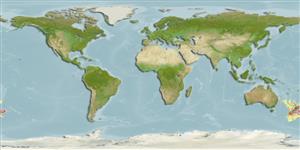Classification / Names
Common names | Synonyms | Catalog of Fishes (gen., sp.) | ITIS | CoL | WoRMS | Cloffa
Elasmobranchii (sharks and rays) >
Carcharhiniformes (Ground sharks) >
Scyliorhinidae (Cat sharks)
Etymology: Apristurus: Greek, a = without + Greek, pristis = saw + Greek, oura = tail (Ref. 45335); exsanguis: Named in reference to its characteristic pale coloration and flaccid body.
Environment / Climate / Range
Ecology
Marine; bathydemersal; depth range 560 - 1200 m (Ref. 40896). Deep-water, preferred ?
Southwest Pacific: New Zealand.
Length at first maturity / Size / Weight / Age
Maturity: Lm ?, range 65 - 70 cm
Max length : 90.8 cm TL male/unsexed; (Ref. 40896)
Short description
Morphology | Morphometrics
Spiral valve turns 12-15; monospondylous vertebrae 40-47; nostril diameter always greater than inter-nostril width; posterior tip of pectoral fin anterior to mid-point of paired fin interspace; the distance between axils of dorsal fins about equal to the anal fin base length; area of the first dorsal fin equal to or slightly less than the area of second; anal fin low with a moderately long base. Pale gray to pale brown in color.
Oviparous (Ref. 50449). Minimum depth from Ref. 58018.
Life cycle and mating behavior
Maturity | Reproduction | Spawning | Eggs | Fecundity | Larvae
Oviparous, paired eggs are laid. Embryos feed solely on yolk (Ref. 50449).
Sato, K., K. Nakaya and A.L. Stewart, 1999. A new species of the deep-water catshark genus Apristurus from New Zealand waters (Chondrichthyes: Scyliorhinidae). J. Roy. Soc. New Zealand 29(4):325-335. (Ref. 40896)
IUCN Red List Status (Ref. 115185)
CITES (Ref. 94142)
Not Evaluated
Threat to humans
Harmless
Human uses
More information
Age/SizeGrowthLength-weightLength-lengthLength-frequenciesMorphometricsMorphologyLarvaeLarval dynamicsRecruitmentAbundance
ReferencesAquacultureAquaculture profileStrainsGeneticsAllele frequenciesHeritabilityDiseasesProcessingMass conversion
Tools
Special reports
Download XML
Internet sources
Estimates of some properties based on models
Phylogenetic diversity index (Ref.
82805): PD
50 = 0.5000 [Uniqueness, from 0.5 = low to 2.0 = high].
Bayesian length-weight: a=0.00324 (0.00157 - 0.00666), b=3.11 (2.93 - 3.29), in cm Total Length, based on LWR estimates for this (Sub)family-body shape (Ref.
93245).
Trophic Level (Ref.
69278): 4.0 ±0.4 se; Based on size and trophs of closest relatives
Resilience (Ref.
69278): Very Low, minimum population doubling time more than 14 years (Fec assumed to be <10).
Vulnerability (Ref.
59153): High vulnerability (59 of 100) .
